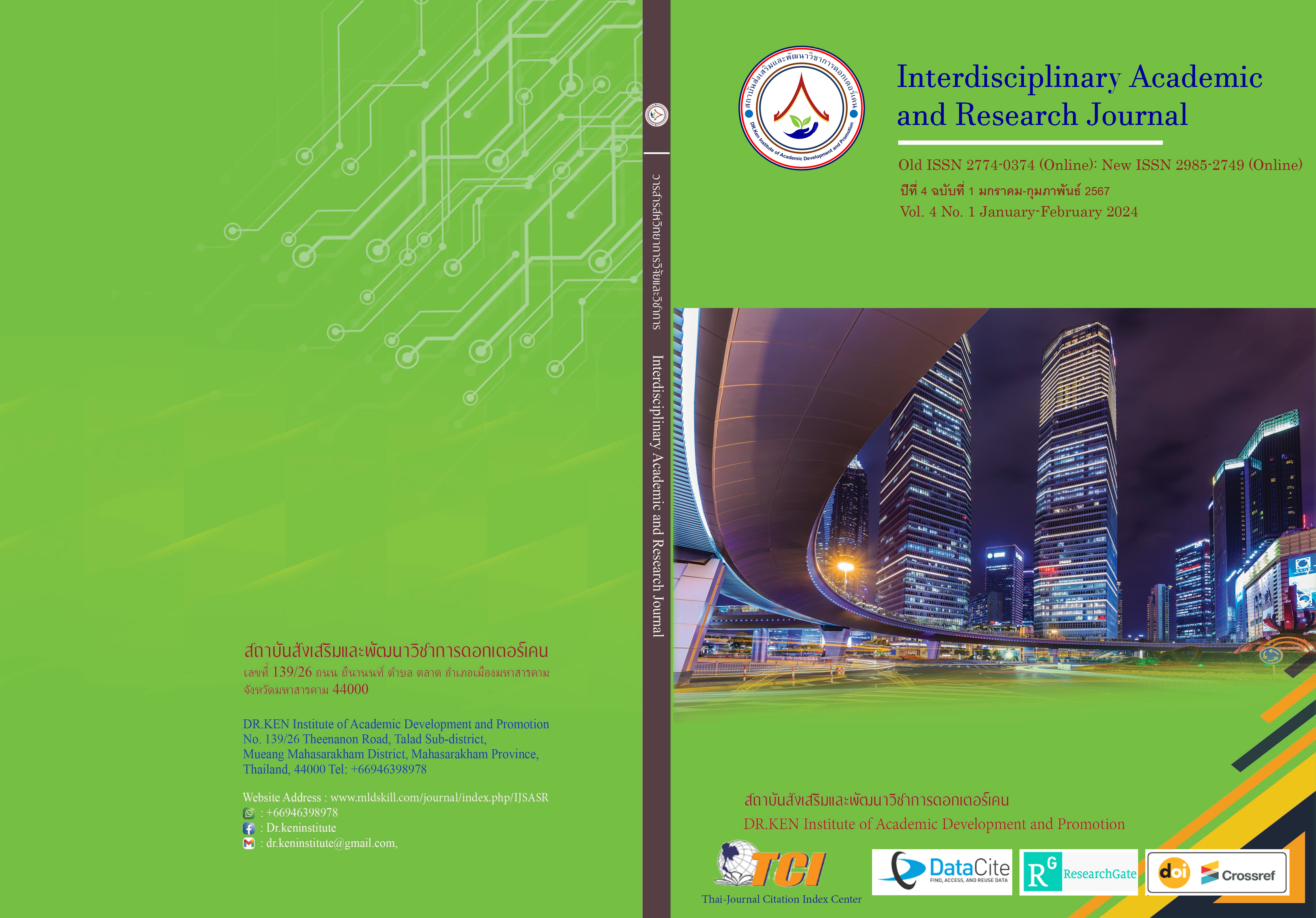The Effect of Music Rhythm and Movement Activities to Promote Physical Development of Young: Early Children
DOI:
https://doi.org/10.60027/iarj.2024.273641Keywords:
Music Rhythm and Movement Activities; , Physical Development of Young Children; , Rhythmic Pacing StudentAbstract
Background and Aims: The researcher sees the importance of physical development and therefore organizes activities that give children the opportunity to perform basic movements combined with creative movement activities that emphasize physical development in balancing skills, walking, running, and jumping. The children can move their bodies freely according to their imagination and ideas, using various equipment. Includes movement of every part of the body. Therefore, this research aimed to compare the physical development of young children before and after organizing music rhythm and movement activities.
Methodology: The target group by purposive sampling was 15 young children, aged 5-6 years old, from Jinchengjiang Aitong Kindergarten in the 2023 academic year. The tools used in this research are Activity plans, music rhythms, and movements. Physical development assessments for young children include balance skills, walking skills, running skills, and jumping skills. The Pre-Experimental Design was used for assessment. The statistics were the average scores, standard deviation, and progress percentage.
Results: The research finding indicated that after organizing the activities, the physical development of young childhood had 31.93 average scores and 2.97 standard deviations higher than 24.46 average scores and 4.70 standard deviations before participating in the activities. The percentage of progress was 84.55.
Conclusion: This research proves that rhythm and movement activities have a positive effect on the physical development of early childhood children. The mean development value increased significantly from 24.46 before the activity to 31.93 after the activity. As a result, we understand the effectiveness of such activities in promoting children's physical development. In addition, the variability of the data was noted. The percentage of progress with a high value of 84.55% clearly shows the higher efficiency of activities in the physical development of early childhood children.
References
กระทรวงศึกษาธิการ. (2560). คู่มือหลักสูตรการศึกษาปฐมวัย พุทธศักราช 2560. สำนักวิชาการและมาตรฐานการศึกษา สำนักงานคณะกรรมการการศึกษาขั้นพื้นฐาน กระทรวงศึกษาธิการ. กรุงเทพฯ : โรงพิมพ์ชุมนุมสหกรณ์การเกษตรแห่งประเทศไทย จำกัด.
กุลยา ตันติผลาชีวะ (2547). การจัดกิจกรรมการเรียนรู้สําหรับเด็กปฐมวัย. กรุงเทพฯ: เอดิสัน เพรสโปรดักส์จํากัด.
กุลยา ตันติผลาชีวะ. (2556). รูปแบบการเรียนการสอนปฐมวัยศึกษา. กรุงเทพฯ : เอดิสันโปรดักส์.
จเร สําอางค์. (2553). ดนตรีเล่น สมองแล่น. สมุทรปราการ : อมรินทร์พริ้นติ้ง แอนด์พับลิชชิ่ง.
จันทร์กฤษณา ผลวิวัฒน์. (2556). การเรียนพิเศษสำหรับเด็กปฐมวัย. Retrieved from: http://taamkru.com/webboard
เทพรัตน์ พานิชยิ่ง. (2553). ผลของการใช้กิจกรรมดนตรีตามแนวคิดของออร์ฟที่มีต่อความคิดสร้างสรรค์ของนักเรียนระดับปฐมวัยโรงเรียนสาธิตมหาวิทยาลัยศรีนครินทรวิโรฒประสานมิตร (ฝ่ายประถม) เขตวัฒนากรุงเทพมหานคร. วิทยานิพนธ์การศึกษามหาบัณฑิต สาขาวิชาจิตวิทยาการศึกษา. บัณฑิตวิทยาลัย : มหาวิทยาลัยศรีนครินทรวิโรฒ.
เบญจา แสงมลิ. (2555). การพัฒนาเด็กปฐมวัย. กรุงเทพฯ : ศูนย์เสริมวิชาการ.
ภรณี คุรุรัตนะ. (2542). การเรียนรู้ของเด็กปฐมวัย (3-5 ปี): แนวคิดของกลุ่มนักศึกษา. กรุงเทพฯ :เซเว่นพริ้นติ้งกรุ๊ป
มหาวิทยาลัยสุโขทัยธรรมาธิราช (2537). หลักการและแนวคิดการประถมวัยศึกษา หน่วยที่ 5-8. กรุงเทพฯ: มหาวิทยาลัยสุโขทัยธรรมาธิราช
รังสฤษฎ์ บุญชะลอ. (2549). กิจกรรมเข้าจังหวะ. กรุงเทพฯ: บริษัทสยามสปอร์ต ซินดิเคท.
ศศกมล ศรีโพธิ์ช้าง. (2557). ความสามารถทางพหุปัญญาของเด็กปฐมวัยที่ได้รับการจัดกิจกรรมเคลื่อนไหวและจังหวะด้วยเครื่องดนตรีไทย. ปริญญานิพนธ์ กศ.ม. (การศึกษาปฐมวัย). กรุงเทพฯ: บัณฑิตวิทยาลัย มหาวิทยาลัย ศรีนครินทรวิโรฒ.
สำนักงานเลขาธิการสภาการศึกษา. (2564). แผนพัฒนาเด็กปฐมวัย พ.ศ. 2564– 2570. กรุงเทพฯ: สำนักงานเลขาธิการสภาการศึกษา.
สิริมา ภิญโญอนันตพงษ์. (2547). การวัดและประเมินแนวใหม่เด็กปฐมวัย. กรุงเทพฯ:ภาควิชาหลักสูตรและการสอน สาขาวิชาการศึกษาปฐมวัย คณะศึกษาศาสตร์มหาวิทยาลัยศรีนครินทรวิโรฒ.
Wu, S., Jiang, G., Li, S., Liu, W., & Li, L. (2015). an empirical study on how rhythmic physical activities promote the gross motor development of young children from the perspective of movement development. Journal of Beijing Sport University.
Yang, Q. (2017). Experimental intervention on the gross motor development of preschool children from the perspective of movement development. Journal of Xi'an Institute of Physical Education.
Downloads
Published
How to Cite
Issue
Section
License
Copyright (c) 2024 Jianmin Tai, Peeraporn Rattanakiat

This work is licensed under a Creative Commons Attribution-NonCommercial-NoDerivatives 4.0 International License.
Copyright on any article in the Interdisciplinary Academic and Research Journal is retained by the author(s) under the under the Creative Commons Attribution-NonCommercial-NoDerivatives 4.0 International License. Permission to use text, content, images, etc. of publication. Any user to read, download, copy, distribute, print, search, or link to the full texts of articles, crawl them for indexing, pass them as data to software, or use them for any other lawful purpose. But do not use it for commercial use or with the intent to benefit any business.
















.png)


